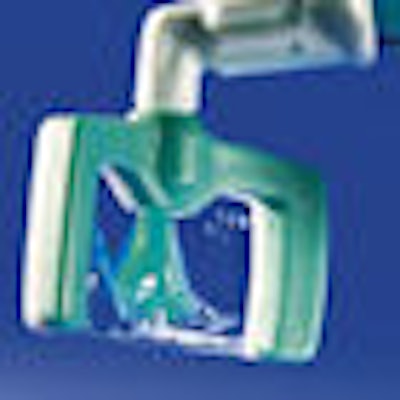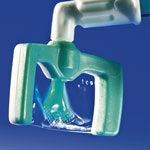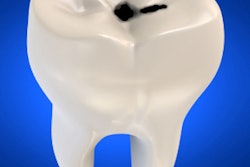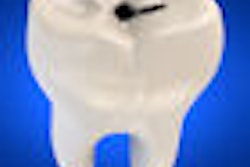
A new caries treatment technique that bridges the gap between remineralization and restoration could do away with that age-old dilemma: Is it better to wait and watch or drill and fill?
Developed by researchers from the University School of Dental Medicine at Charité Medical University in Berlin, the technique -- resin infiltration -- has been exclusively licensed to DMG, which is commercializing it under the brand name Icon. The company introduced the Icon system to the European dental community at the International Dental Show (IDS) in Germany earlier this year and plans to launch it in the U.S. this fall at the ADA meeting, according to Wayne Flavin, director of scientific affairs for DMG America.
 |
| Proximal tip of the Icon caries infiltration device from DMG. Image courtesy of DMG. |
Invented by Sebastian Paris, D.D.S, and Hendrik Meyer-Lückel, D.D.S., resin infiltration utilizes the concept of capillary forces -- "similar to a sugar cube soaking up coffee," Dr. Paris said in an e-mail to DrBicuspid.com. The pseudointact surface layer of the caries is first eroded by etching the lesion for 120 seconds with 15% hydrochloric acid gel (this layer would otherwise hamper penetration, Dr. Paris said). The lesion is then desiccated with ethanol and air blowing and the infiltrant -- a proprietary resin -- is applied, penetrating into the porous lesion via the capillary forces.
"The secret to Icon and to infiltration is the resin, which has an extremely high penetration coefficient," Flavin said. "The best bonding agents on the market today infiltrate 10 to 12 microns into the tooth structure. Icon infiltrates 600 microns, and it can fully infiltrate a lesion in only two to three minutes."
After three minutes, the excess material is removed from the lesion surface and the material is light cured, leaving no resin coat on the lesion surface. Rather, the resin occludes the lesion pores inside the lesion body, thus preventing diffusion of cariogenic acids into the lesion, Dr. Paris explained. In the process, however, the sealing process also eliminates the possibility of remineralization, he said.
"Infiltration is not indicated for lesions where remineralization is the first choice. Of course we aim for remineralization of lesions first, by local fluoridation, oral hygiene education, and dietary control," Dr. Paris noted. "However, if this approach fails, at a certain point lesions have to be restored with fillings. Using caries infiltration, we want to delay or even prevent this first operative intervention."
Although remineralization works well on shallow lesions, Flavin noted, "when you get to deeper lesions, such as one that has progressed through the enamel-dentin junction and into the first third of the dentin, you are probably not going to have great success with remineralization. And this is where infiltration comes in. Rather than reaching for a handpiece, this offers the option to treat the lesions using very minimally invasive procedures."
But Douglas Young, D.D.S., an associate professor at the University of the Pacific School of Dentistry, disagrees that deeper lesions have less success of remineralization.
"Remineralization can happen at any stage, and the important question should be not how deep the demineralization goes, but is the lesion cavitated," he said in an e-mail to DrBicuspid.com. "If the lesion is not cavitated, then bacteria are physically too big to get into the dentin; therefore, remineralization can (and perhaps should) be done first."
Resin infiltration is intended for use only on noncavitated lesions, Flavin noted.
Clinical research
Dr. Paris and his colleagues have been publishing on resin infiltration since 2006, addressing various aspects of the infiltration technique, such as evaluating different etching gels for pretreatment purposes (Journal of Dental Research, 2007, Vol. 86:7, pp. 662-666); comparing the penetration coefficients of a proprietary resin formulation to commercially available adhesives (Journal of Dental Research, 2008, Vol. 87:12, pp. 1112-1116); and validating the ability of fluorescence confocal microscopy to analyze the infiltration of caries lesions with low-viscosity resins (Microscopy Research and Technique, July 2009, Vol. 72:7, pp. 489-494).
More recently, at this year's International Association for Dental Research (IADR) meeting, they presented two additional studies involving resin infiltration: "Progression of resin-infiltrated natural caries lesions in vitro" and "Modern detection, assessment, and treatment of initial approximal lesions."
In the first study, they applied the infiltration process to extracted teeth, etching the teeth with 15% hydrochloric acid gel for 120 seconds and then infiltrating with one of four experimental infiltrants -- bisphenol A glycidyl methacrylate (BisGMA) 25%, triethylene glycol dimethacrylate (TEGDMA) 75%; BisGMA 20%, TEGDMA 60%, ethanol 20%; TEGDMA 100%; and TEGDMA 80%, ethanol 20% -- for five minutes. Specimens of the teeth were then exposed to a demineralizing solution (pH 4.95) for 200 days. After imaging with microradiography, they found that the lesions treated with the latter three infiltrants all showed lower progression rates in a demineralizing environment in vitro than lesions that were not treated with infiltrants.
The second study, sponsored by DMG, compared resin infiltration to flossing and sealing of approximal lesions around the enamel-dentin junction as part of an ongoing three-year, split-mouth study on approximal-posterior surfaces and preventive procedures. The study concluded that "the infiltration technique has been described as a clinically feasible method for treating approximal enamel-dentin junction lesions."
While resin infiltration clearly offers dentists another minimally invasive caries treatment option, because it is such a new approach there needs to be more research, Dr. Young said. Additional studies are under way in the U.S. at the University of Michigan, Case Western Reserve, and the University of Alabama and in Germany, Denmark, and Colombia, according to DMG.
For more information about the science and research behind the resin infiltration technique being commercialized by DMG, go to www.dmg-dental.com.
Copyright © 2009 DrBicuspid.com



















